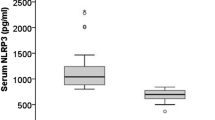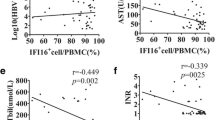Abstract
The basic idea behind this study was to discover the association and prevalence of purinoceptors in hepatitis C virus (HCV) and non-HCV hepatocellular carcinoma (HCC). Immunohistochemistry was performed to study the expression of P2X4 and P2X7 receptors on ex-planted liver tissue samples that were collected from HCC patients. Antibodies specific for the P2X4 and P2X7 receptors were used to target the specific receptors and secondary antibody was used with 3,3′-diaminobenzidine (DAB) detection system to visualize the color change in case of any positive expression There was a substantial increase in P2X4 receptor expression in HCV induced HCC as compared to non-HCV HCC. Surprisingly, there was no increase in the P2X7 receptor expression in both HCV HCC and non-HCV HCC. We conclude that P2X4 receptor expression was significant in the presence of HCV HCC. This may confirms the potential role of P2X4 receptor in the presence of virus in liver pathology. However insignificant expression of P2X7 receptor may avert our attention towards understanding the role of this receptor in pro-inflammatory and immune responses.


Similar content being viewed by others
References
Saalim M, Resham S, Manzoor S et al (2016) IL-22: a promising candidate to inhibit viral-induced liver disease progression and hepatocellular carcinoma. Tumor Biol 37:105–114
Bandiera S, Billie Bian C, Hoshida Y et al (2016) Chronic hepatitis C virus infection and pathogenesis of hepatocellular carcinoma. Curr Opin Virol 20:99–105
Manzoor S, Akhtar U, Naseem S et al (2016) Ionotropic purinergic receptors P2X4 and P2X7: proviral or antiviral? an insight into P2X receptor signaling and hepatitis C virus infection. Viral Immunol 29:401–408
Bhatti ABH, Dar FS, Waheed A et al (2016) Hepatocellular carcinoma in Pakistan: National Trends and Global Perspective. Gastroenterol Res Pract 2016:5942306
Ashraf W, Manzoor S, Ashraf J et al (2013) Transcript analysis of P2X receptors in PBMCs of chronic HCV patients: an insight into antiviral treatment response and HCV-induced pathogenesis. Viral Immunol 26:343–350
Di Virgilio F, Adinolfi E (2016) Extracellular purines, purinergic receptors and tumor growth. Oncogene. https://doi.org/10.1038/onc.2016.206
Bodin P, Burnstock G (2001) Purinergic signalling: ATP release. Neurochem Res 26:959–969
Pellegatti P, Raffaghello L, Bianchi G et al (2008) Increased level of extracellular ATP at tumor sites: in vivo imaging with plasma membrane luciferase. PLoS ONE 37:e2599
Falzoni S, Donvito G, Di Virgilio F (2013) Detecting adenosine triphosphate in the pericellular space. Interface Focus 3:20120101–20120101
Ralevic V, Burnstock G (1998) Receptors for purines and pyrimidines. Pharmacol Rev 50:413–492
North RA (2002) Molecular physiology of P2X receptors. Physiol Rev 82:1013–1067
Khakh BS, North RA (2006) P2X receptors as cell-surface ATP sensors in health and disease. Nature 442:527–532
Manzoor S, Idrees M, Ashraf J et al (2011) Identification of ionotrophic purinergic receptors in Huh-7 cells and their response towards structural proteins of HCV genotype 3a. Virol J 8:431
North RA, Surprenant A (2000) Pharmacology of cloned P2X receptors. Annu Rev Pharmacol Toxicol 40:563–580
Gupta GP, Massagué J (2006) Cancer metastasis: building a framework. Cell 127:679–695
Ando T, Imamura H, Suzuki R et al (2012) Visualization and measurement of ATP levels in living cells replicating hepatitis C virus genome RNA. PLoS Pathog 8:e1002561
Adinolfi E, Melchiorri L, Falzoni S et al (2002) P2X7 receptor expression in evolutive and indolent forms of chronic B lymphocytic leukemia. Blood 99:706–708
Adinolfi E, Cirillo M, Woltersdorf R et al (2010) Trophic activity of a naturally occurring truncated isoform of the P2X7 receptor. FASEB J 24:3393–3404
Jelassi B, Chantôme A, Alcaraz-Pérez F et al (2011) P2 × (7) receptor activation enhances SK3 channels- and cystein cathepsin-dependent cancer cells invasiveness. Oncogene 30:2108–2122
Adinolfi E, Raffaghello L, Giuliani AL et al (2012) Expression of P2X7 receptor increases in vivo tumor growth. Cancer Res 72:2957–2969
Jelassi B, Anchelin M, Chamouton J et al (2013) Anthraquinone emodin inhibits human cancer cell invasiveness by antagonizing P2X7 receptors. Carcinogenesis 34:1487–1496
Giuliani AL, Colognesi D, Ricco T et al (2014) Trophic activity of human P2X7 receptor isoforms A and B in osteosarcoma. PLoS ONE 9:e107224
Qiu Y, Li W-H, Zhang H-Q et al (2014) P2X7 mediates ATP-driven invasiveness in prostate cancer cells. PLoS ONE 9:e114371
Adinolfi E, Capece M, Franceschini A et al (2015) Accelerated tumor progression in mice lacking the ATP receptor P2X7. Cancer Res 75:635–644
Zhou JZ, Riquelme MA, Gao X et al (2015) Differential impact of adenosine nucleotides released by osteocytes on breast cancer growth and bone metastasis. Oncogene 34:1831–1842
Xia J, Yu X, Tang L et al (2015) P2X7 receptor stimulates breast cancer cell invasion and migration via the AKT pathway. Oncol Rep 34:103–110
Amoroso F, Capece M, Rotondo A et al (2015) The P2X7 receptor is a key modulator of the PI3K/GSK3β/VEGF signaling network: evidence in experimental neuroblastoma. Oncogene 34:5240–5251
Giannuzzo A, Pedersen SF, Novak I (2015) The P2X7 receptor regulates cell survival, migration and invasion of pancreatic ductal adenocarcinoma cells. Mol Cancer 14:203
Schöfl C, Ponczek M, Mader T et al (1999) Regulation of cytosolic free calcium concentration by extracellular nucleotides in human hepatocytes. Am J Physiol 276:G164–G172
Emmett DS, Feranchak A, Kilic G et al (2008) Characterization of ionotrophic purinergic receptors in hepatocytes. Hepatology 47:698–705
Khalid M, Brisson L, Tariq M et al (2017) Carcinoma-specific expression of P2Y11 receptor and its contribution in ATP-induced purinergic signalling and cell migration in human hepatocellular carcinoma cells. Oncotarget 8(23):37278–37290
Ilahi NE, Anwar S, Noreen M et al (2016) Detection of human papillomavirus-16 DNA in archived clinical samples of breast and lung cancer patients from North Pakistan. J Cancer Res Clin Oncol 142:2497–2502
Balogh J, Victor D, Asham EH et al (2016) Hepatocellular carcinoma: a review. J Hepatocell Carcinoma 3:41–53
Umer M (2016) Hepatitis C virus prevalence and genotype distribution in Pakistan: comprehensive review of recent data. World J Gastroenterol 22:1684
Dubyak GR (2012) P2X7 receptor regulation of non-classical secretion from immune effector cells. Cell Microbiol 14:1697–1706
Xiao F, Waldrop SL, Khimji A, Kilic G (2012) Pannexin1 contributes to pathophysiological ATP release in lipoapoptosis induced by saturated free fatty acids in liver cells. Am J Physiol Cell Physiol 303:C1034–C1044
Fausther M, Gonzales E, Dranoff JA (2012) Role of purinergic P2X receptors in the control of liver homeostasis. Wiley Interdiscip Rev Membr Transp Signal 1:341–348
Schöfl C, Ponczek M, Mader T, Waring M, Benecke H, von zur Mühlen A, Mix H, Cornberg M, Böker KH, Manns MP, Wagner S (1999) Regulation of cytosolic free calcium concentration by extracellular nucleotides in human hepatocytes. Am J Physiol 276:G164–G172
Ferrari D, Pizzirani C, Adinolfi E et al (2006) The P2X7 receptor: a key player in IL-1 processing and release. J Immunol 176:3877–3883
Ohsawa K, Irino Y, Nakamura Y et al (2007) Involvement of P2X4 and P2Y 12 receptors in ATP-induced microglial chemotaxis. Glia 55:604–616
Lecut C, Frederix K, Johnson DM et al (2009) P2X1 ion channels promote neutrophil chemotaxis through rho kinase activation. J Immunol 183:2801–2809
Abramowski P, Ogrodowczyk C, Martin R, Pongs O (2014) A truncation variant of the cation channel P2RX5 is upregulated during T cell activation. PLoS ONE 9:e104692
Francesco DV, Diego DB, Alba CS et al (2017) The P2X7 receptor in infection and inflammation. J Immun 47:15–31
Taylor JM, Han Z (2010) Purinergic receptor functionality is necessary for infection of human hepatocytes by hepatitis delta virus and hepatitis B virus. PLoS ONE 5:e157
Acknowledgements
We are thankful to higher education commission and NUST for providing the opportunity to conduct this research work. We are also thankful to Liver transplant unit of Shaikh Zayed Hospital Lahore in coordinating this research work.
Author information
Authors and Affiliations
Corresponding author
Ethics declarations
Conflict of interest
The authors, who contributed for this review paper, do not hold any kind of the conflict of interest.
Research involving human participants and/or animals
This article involved liver biopsy samples from human participants, and does not contain any studies with animals performed by any of the authors.
Informed consent
Informed consent was obtained from all individual participants included in the study.
Rights and permissions
About this article
Cite this article
Khalid, M., Manzoor, S., Ahmad, H. et al. Purinoceptor expression in hepatocellular virus (HCV)-induced and non-HCV hepatocellular carcinoma: an insight into the proviral role of the P2X4 receptor. Mol Biol Rep 45, 2625–2630 (2018). https://doi.org/10.1007/s11033-018-4432-0
Received:
Accepted:
Published:
Issue Date:
DOI: https://doi.org/10.1007/s11033-018-4432-0




